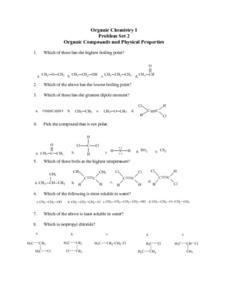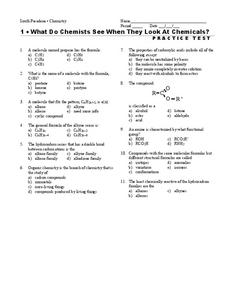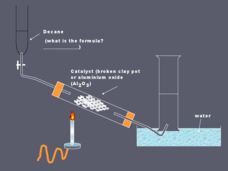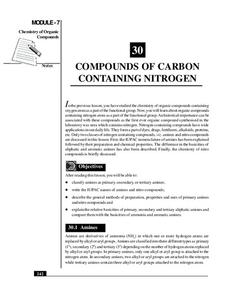Normal Community High School
Alkane Nomenclature
Given the line structure or IUPAC name, advanced chemists provide the line structure or chemical name for twenty alkanes. This straightforward assignment can be given as homework during your organic chemistry unit.
Curated OER
Organic Chemistry-Condensed Structural Formulas
In this structural formulas worksheet, students are given three condensed structural formulas and three non-condensed structural formulas. They draw the structural and graphic formulas for each compound.
Curated OER
Organic Chemistry-Emphatically Aliphatic
In this aliphatic worksheet, students are given eight hydrocarbon molecules. They determine if they are alkanes, alkenes or alkynes. They draw a diagram of each and indicate if they are saturated or unsaturated.
Curated OER
Organic Chemistry-Naming Hydrocarbons
In this naming hydrocarbons worksheet, students are given a table of the prefixes used for naming hydrocarbons based on the number of carbon atoms and their location. They then practice naming ten hydrocarbon compounds using the rules of...
Curated OER
Chemistry 115 Practice Exam 3
Radioactive decay, pH, properties of elements, organic compounds, and stoichiometry are all touched upon through this practice chemistry exam. It always helps learners to take a practice test in preparation for the actual exam. This...
Curated OER
Organic Compounds and Physical Properties
In this chemistry worksheet, learners identify which has the highest boiling point, as well as the lowest. Then they identify which compound is least soluble in water and why. Students also classify each of the compounds listed on the...
Curated OER
Alkene Addition Reactions-Problem Set 18
In this organic chemistry worksheet, students complete 10 questions in which they identify the structural formulas for the products of reactions.
Chemistry Collective
Virtual Lab: Determining the pKa and Concentration Ratio of a Protein in Solution
It's pretty common to determine the dissociation constant for an acid or a base ... but, what about a protein? Challenge your class with a virtual lab designed to further develop their acid-base chemistry skills. Individuals determine...
Curated OER
Is Organic Food Worth the Extra Cost?
Young scholars calculate the amount of pesticide residue in selected foods for two
pesticides and determine if these levels are safe. They read an article about a
research study looking for metabolites of these pesticides in children....
Curated OER
Chemistry Unit on Compounds, Formulas, and Equations
Students perform a review assignment in 3 portions to review chemistry compounds, formulas, and equations. The assignment consists of several different portions that can be used as assessments. The majority of the lesson plan is composed...
Curated OER
What do Chemists See When they Look at Chemicals?
In this chemicals worksheet, students answer 15 multiple choice questions about chemicals, compounds, inorganic and organic molecules.
Curated OER
Chemistry in Action
For this chemistry in action worksheet, learners read about sulphuric acid, the use of metals, the production of titanium and the detection of chemical elements and compounds. Students are given 8 statements about what they should know...
Curated OER
Addition Reactions
Here is a PowerPoint that displays multiple organic compound structures and asks viewers to identify the formulas, isomers, or potential products after a given addition reaction. This is a comprehensive set of slides that reviews...
National Institute of Open Schooling
Nomenclature and General Principles
Carbon, the base for all organic compounds, exists in nature in its purest form as graphite or diamonds. The 25th lesson in a series of 36 teaches pupils the nomenclature of organic compounds. Learners read about how to use the IUPAC...
Curated OER
Polymers all Over the Place
Students investigate properties of common molecules. In this chemistry lesson, students construct polymer models to gain a better understanding of the properties of polymers.
Curated OER
# 03 Laboratory Ventilation and Risk Assessment Exercise
Students are introduced to the analysis of health risks in the laboratory, particularly from vapors from organic solvents. They consider quantitative measure of risk such as threshold limit values (TLVs), the amount of the compound that...
Baylor College
Pre-Assessment: The Brain
Break your class in to the general structure and function of the brain. Brainiacs discuss what they know about it and create personalized brain development timelines. They also take a true-false, pre-assessment quiz to get them thinking...
Baylor College
What Is a Neuron?
Your class won't get on your nerves while doing this modeling activity! After teaching the structure and function of a neuron using the included diagrams, give individuals some clay and chenille stems so that they can make their own...
Curated OER
Plastics Crossword
In this chemistry worksheet, students look for the solutions to the crossword puzzle that is based upon the topic of plastics. The sheet is helpful for vocabulary.
Curated OER
The Right Chemistry
Students see that chemistry is the study of matter, how matter reacts and combines to create new chemicals, the changes that take place in matter and what makes up matter. This lesson plan provides many good ideas across the curriculum...
Curated OER
Reactions of Benzene
For this chemistry worksheet, students write the products for each of the given reactions. Then they write N.R. if there is no reaction present. There are eight reactions to identify on the sheet.
Curated OER
Chemistry
In this chemistry worksheet, students classify each chemical compound as a ketone, amine, aldehyde, or ether. Students also write a condensed formula and classification for the given organic products.
Curated OER
Let's Make a Tubeworm!
Students discuss deep-sea chemosynthetic communities then create a poster of a three-dimensional tubeworm. In this creative lesson students create their own tubeworm and write a written report on it.
National Institute of Open Schooling
Compounds of Carbon Containing Nitrogen
Amines are vital to humans because they help form amino acids, the building blocks of proteins. The 30th lesson in a series of 36 specifically focuses on the organic compounds that contain nitrogen. Learners classify amines and nitro...
Other popular searches
- Organic Chemistry Projects
- Organic Chemistry Activities
- Naming Organic Chemistry
- Organic Chemistry Alcohols
- Organic Chemistry Lab
- Organic Chemistry Model Sets
- Organic Chemistry Quizzes
- Organic Chemistry Detergent
- Simple Organic Chemistry
- Organic Chemistry Reactions
- What Is Organic Chemistry
- Organic Chemistry I

























